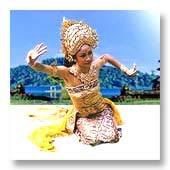Although there are no artifacts or records dating back to the Stone Age, it is believed that the first settlers on Bali migrated from China around 2500 BC. By the Bronze era, around 300 B.C. quite an evolved culture existed in Bali. The complex system of irrigation and rice production, still in use today, was established around this time.
History is vague for the first few centuries. A number of Hindu artifacts have been found dating back to the 1st century, yet it appears that the main religion, around 500 AD was predominantly Buddhist in influence. A Chinese scholar, Yi-Tsing, in 670 AD reported on a trip to India, that he had visited a Buddhist country called Bali.
It wasn't until the 11th century that Bali received the first strong influx of Hindu and Javanese cultures. With the death of his father around AD 1011, the Balinese Prince, Airlanggha, moved to East Java and set about uniting it under one principality. Having succeeded, he then appointed his brother, Anak Wungsu, as ruler of Bali. During the ensuing period there was a reciprocation of political and artistic ideas. The old Javanese language, Kawi, became the language used by the aristocracy, one of the many Javanese traits and customs adopted by the cause.
With the death of Airlanggha, in the middle of the 11th century, Bali enjoyed a period of autonomy. However, this proved to be short-lived as in 1284, the East Javanese king Kertanegara, conquered Bali and ruled over it from Java. In 1292, Kertanegara was murdered and Bali took the opportunity to liberate itself once again. However, in 1343, Bali was brought back under Javanese control by its defeat at the hands of Gajah Mada, a general in the last of the great Hindu-Javanese empires, the Majapahit. With the spread of Islam throughout Sumatra and Java during the 16th century, the Majapahit Empire began to collapse and a large exodus of aristocracy, priests, artists and artisans to Bali ensued. For a while Bali flourished and the following centuries were considered the Golden Age of Bali's cultural history. The principality of Gelgel, near Klungkung, became a major centre for the Arts, and Bali became the major power of the region, taking control of neighboring Lombok and parts of East Java.
* Dreamland Villa
* Dreamland Hotel
* Nice for surfing












